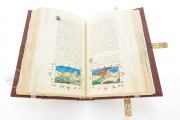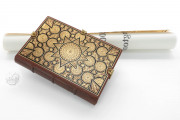Made in Florence around 1460-1480, the manuscript of Fiore di Virtù and La Sfera in the Riccardiana is a handsomely illuminated manuscript that exemplifies the humanistic interest in the human spirit and the natural world. It combines a prose Italian-language compendium of knowledge and sayings about virtues and vices with a poem in Italian that treats astronomy and geography. Mariano del Buono, a painter involved in many important commissions for wealthy Florentines, provided most of the illumination comprising fifty bas-de-page miniatures and two borders.
Fiore di Virtù was composed around 1320 by a certain "Brother Thomas," drawing from authors of Greek and Roman antiquity and the Middle Ages (including his contemporaries). La Sfera was written by one of the Dati brothers, Leonardo (1408-1472) or Gregorio (1362-1436). It comprises 144 eight-line stanzas, the first half of the text treating the cosmos and the second physical geography.
A Busy Florentine Illuminator
Mariano del Buono (1433-1504) was active in Florence in the second half of the fifteenth century. He was an illuminator of Latin, Italian, and Hebrew manuscripts and a supplier of materials for making manuscripts. He painted the full-page white vine-stem border that opens Fiore di Virtù (fol. 2r), its thirty-five miniatures, and the quarter-page border at the beginning of La Sfera (fol. 74r).
Animal Lore in Pictures
For each of the thirty-five virtues and vices, the author of Fiore provided a definition, a story from the animal world meant to teach a moral lesson, maxims (sayings), and an exemplum (a moralizing tale). In each case, a miniature illustrates the animal lore. Mariano's miniatures, framed in gold, depict the animal in a detailed landscape with an atmospheric blue sky. A charming example is the miniature of the bear as an emblem of the vice of anger. It gives a masterful sense of the bear's ire at the large bees surrounding it (fol. 18r).
Cosmos and Geography
The miniatures of the first part of La Sfera present the zodiac, phases of the moon, cycles of eclipses, climactic zones, and other cosmological subjects in circular diagrammatic miniatures in the bas-de-page. These give way to a series of maps occupying the bas-de-pages and often extending into the side margins. A map of the Middle East—which shows the biblical ark of Noah on Mount Ararat—spreads across two facing pages (fols. 95v-96r).
Two Texts, One Scribe
Although the two texts treat different subjects, the manuscript was conceived as a unit, with the stylistic consistency of the painted borders at the opening of each text harmonizing the work. The manuscript is in Humanistic Cursive script, and it is conceivable—but not provable—that the scribe was an adolescent Amerigo Vespucci (1451-1512).
Marks of an Early Reader
Starting in chapter 3 of Fiore, an early reader drew attention to each description of the equation of an abstract concept with a member of the animal or avian world. The first six of these marginal notations comprise the Latin word comparatione ("by comparison") and a pointing hand with an impossibly long and thin index finger (fols. 13r, 14r, 16v, 18r, 20v, and 22r). After that, the word alone suffices. Tommaso Cavalcanti (d. 1560) owned the manuscript in 1533 when he added an inscription to a flyleaf.
We have 1 facsimile edition of the manuscript "Fiore di Virtù and La Sfera": Fior di Virtù facsimile edition, published by ArtCodex, 2015
Request Info / Price































